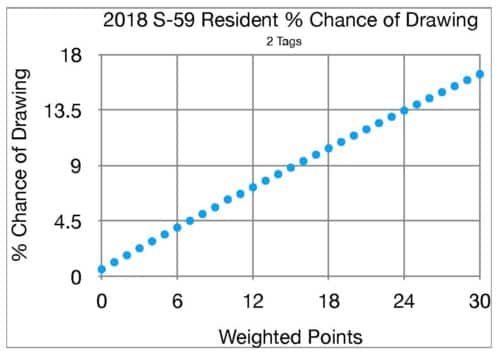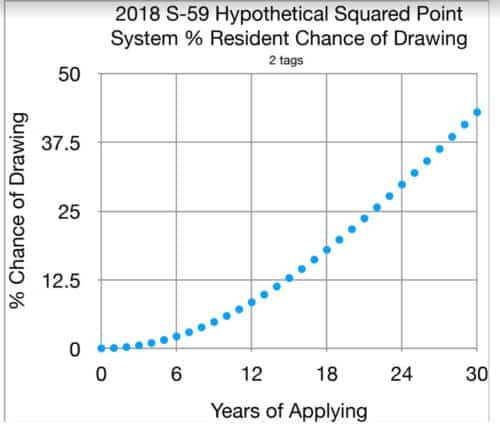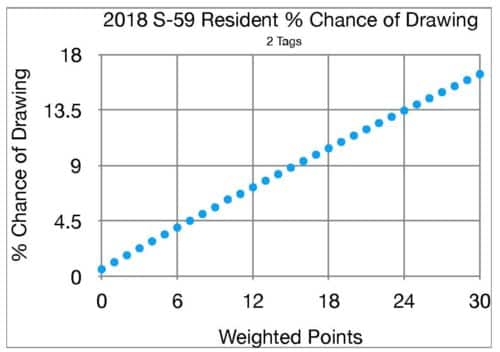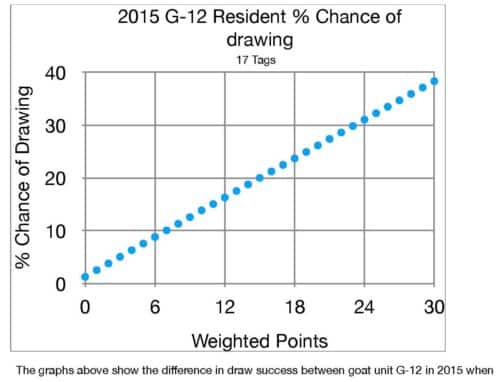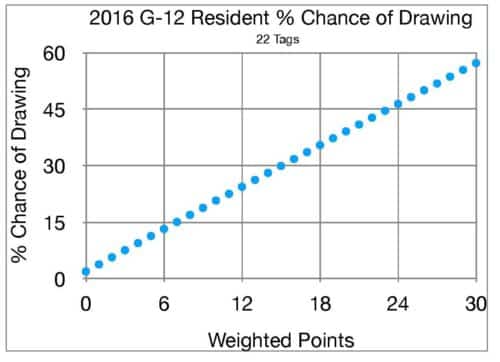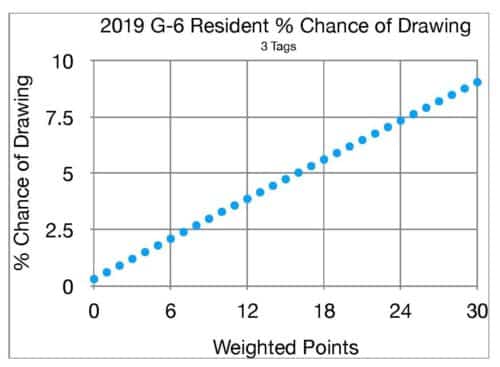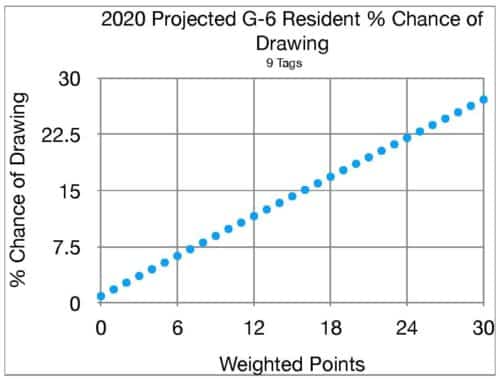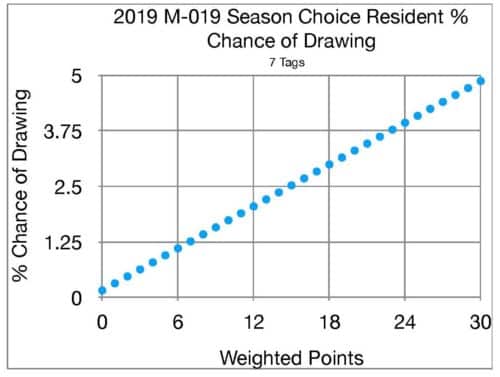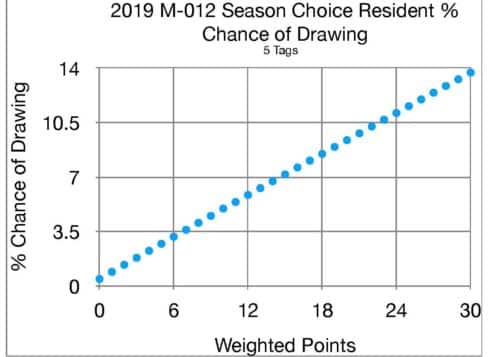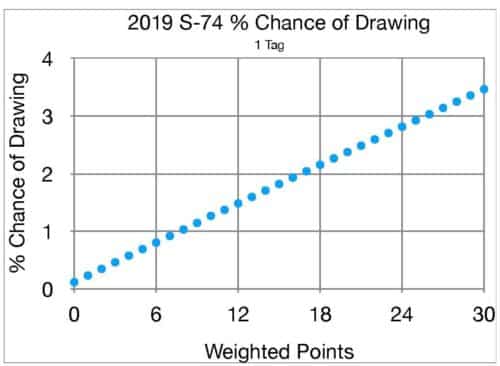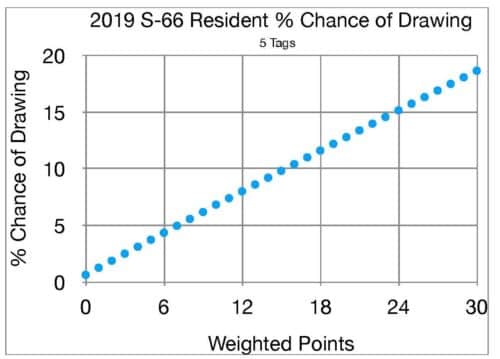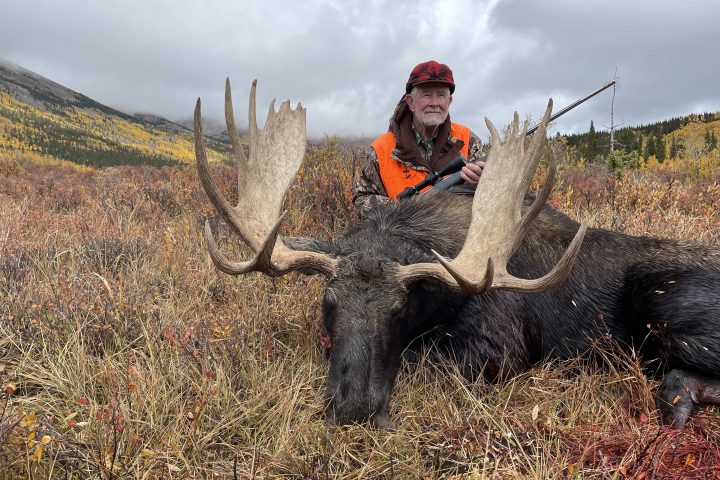Key Takeaway:
Each year we get a number of phone calls from hunters that have 20+ points for the specialty species. They have historically applied for points only, but this year they are going to start applying for tags! Unfortunately, these hunters don’t understand how much of the Colorado sheep hunting opportunity they have already missed out on. They don’t realize that the odds of drawing a sheep/goat/moose tag are very low, even when you have 20+ points. This is due to the Colorado weighted point system. If you take anything away from this article: APPLY TO HUNT EVERY YEAR! The cumulative probability of drawing while applying for hunts for 20 years, outweighs the chances of drawing a tag in year 21 by 10-15x, in most cases. If you wait years, accumulating points without applying for the actual hunts, you run the serious risk of never drawing a sheep, goat, or moose tag in Colorado.
How the weighted draw works:
The Colorado draws for sheep, goat, and moose differ from other Western states. First, Colorado has their moose, sheep, and goat draw setup so you are required to have three preference points before you can even draw a tag. During your fourth year of applying, you can potentially draw a tag. That year and each consecutive year you gain a “weighted point”.
The draw works by assigning a random 12 digit number to each applicant. The computer then divides the random 12 digit number by the number of weighted points plus one. The applicants with the lowest number receive the tags.
However, at this point, think of the mechanics of the draw in terms of raffle tickets. These weighted points represent the number of tickets (plus one) you get in the pot. (Note: the graphs in this article do not show the +1 point, but it is in the spreadsheet that creates the graphs). By thinking of the draw like this, it’s easier to comprehend and the math is the exact same.
The idea of applying every year can be thought of as attending a sportsman’s banquet. If you’ve ever been to one, there is always the lucky person that wins a gun even though they only had 1 ticket in the jar and you had 100.
So, let’s say 18 years ago you decided to start applying for sheep in Colorado; the first three years were spent building your preference points. The next 15 years you received a weighted point for each unsuccessful year in the draw. In year 19, you have 16 “tickets” in the raffle. This system produces a linear graph of draw percentage success. Each year you have a steady, though minimal, rate of increasing success percentage. See graph below.
The Colorado system is a little different than some other Western states like Nevada, that square your points and in turn show an exponential increase of draw success as you increase points. Each year you apply, they square the number of preference points and add 1 to the total. If you applied for 18 years in Nevada at the same time as you did in Colorado, on the 18th year you have 325 raffle tickets vs Colorado’s 16. What this means for you, is that the odds of drawing when you initially begin to apply are higher in Colorado instead of Nevada, but as you get more points the odds of drawing are much higher in Nevada. See graph below.
Note: In this graph using the “Nevada” squared system you do not have the initial three years of applying where you are not eligible. This means that your first year you decide to build points you have a chance to draw. Where as in Colorado you the first three years you are not even eligible to enter the draw. So in the first graph on your 30th weighted point it is actually year 33 of applying. If you applied for 33 years in the squared system you would actually have 49.7% chance of drawing the tag in the single next year.
Let’s Look at Some Units We are Familiar with Here at FTWG
What To Look For When Applying Each Year:
I see a lot of folks that apply for the same unit each year. They did the research and the mix between draw success, quality, or quantity of animals made sense to them. That’s great, but things change. Many units may not change the total quota of animals, but the quota may be all residents one year and then add a non-resident the following year. If you are a non-resident this is something to pay attention to! Each year I talk to folks that want to apply for a unit that had a non-resident tag the year before but not for this year. For residents this is also something to pay attention to.
Because many hunters do not look at these resident vs non-resident quota shifts, the changes effect the draw success probability significantly! I do however understand that some hunters want to hunt their “home” unit because they know the area, the animals, terrain, etc. If you fall in this category and you do not feel comfortable hunting a new area then good on you, but just know that your odds of drawing the tag are going to be lower.
Above are two graphs both for the same sheep unit, S-59. The difference is that in 2019 there was 1 resident tag and 1 non-resident tag (the graphs are for resident only in this example). In 2019, you can see that the draw success for the resident was significantly lower than that of 2018 when they gave two resident tags and no non-resident tags.
Another thing to look at is when Colorado Parks and Wildlife increases the number of tags in a unit.
The graphs above show the difference in draw success between goat unit G-12 in 2015 when they issued 17 tags vs G-12 in 2016 when they increased the amount of tags to 22. Sure, more people applied but not enough to equalize the draw success for the additional 5 tags.
The graphs below depict similar situations. The amount of goat tags given out in 2019 for G-6 were 3, in 2020 they will give out 9. The graphs are a prediction if the number of people applying stayed the same, while the number of people that have each amount of points stays constant. Obviously, this is not a perfectly accurate prediction of draw success. There will most likely be more people applying, but that increase will not make up for the additional tags. Tags will be easier to draw in the unit in 2020 vs 2019.
Another thing to look at is choosing a super high demand unit. This may mean that the quality is great, but it also means that a lot of people want that unit. We see this all the time across species. For example, let’s look at moose. Unit 12, 23, and 24 are all under the same tag. In 2019, Colorado gave out 5 bull tags for unit 12 and they gave 7 for unit 19. Unit 12 is in the Northwestern part of the state, fairly unpopulated, hard to get there and according to goHUNT Insider (an online hunt planner) classifies trophy potential of moose in unit 12 as, “Moose occasionally getting 40” wide”. Unit 19 is on the Front Range outside of Fort Collins, close to home for a lot of people to go scout, see moose regularly as they go hiking with the family, etc. In unit 19 goHUNT Insider classifies it’s trophy potential as “Most bulls have 40”-50” spread. A giant 56” bull was harvested with a bow in 2015.” While it’s true that unit 19 probably has better genetics than unit 12, it is also way harder to draw. Most folks don’t realize HOW MUCH harder. Below are two graphs, one for each unit in 2019.
Other situations to keep an eye on are what hunt resources such as Epic Outdoors or Huntin’ Fool recommend. They know what units have great quality and may be very hard to draw. They also might publicize a sleeper unit. These units can “blow up” with popularity from year to year.
Have a Lifelong Strategy and Understand the Tradeoffs
Let’s say you are 30 years old and you want to hunt sheep and moose in Colorado. We can safely assume that drawing a tag will get harder in the future, looking at current trends. However, 2019 probabilities can give us a ballpark estimate of things. We will look at sheep units first. In this case, we are focused in on S-66, a good unit with decent draw odds. We will also look at S-74 which is a much harder to draw unit, bigger rams and less hunter competition.
The tables and graphs below show the odds of drawing the S-66 vs S-74 tags. You want to consider the chances for any given year (graphs) AND the cumulative chances (tables) of drawing over a number of years. A stunning observation for most folks is that if you apply for S-74 for 30+ years, your chances of drawing are still less than 50% (43.29% to be exact). If you were applying for S-66 over that same 30+ years, the result is an almost guarantee that you will draw (96.06%). Statistically, you actually have a better chance of drawing S-66 twice over 30 years than you do of drawing S-74 once! Also, note that if you start taking years off to “just put in for points” your cumulative probability of drawing falls way off!
| Resident S-66 | |
| Years Applying – 3 | % Cumulative Chance of Drawing Resident Tag* |
| 30 | 96.06 |
| 29 | 95.15 |
| 28 | 94.08 |
| 27 | 92.83 |
| 26 | 91.37 |
| 25 | 89.69 |
| 24 | 87.77 |
| 23 | 85.58 |
| 22 | 83.12 |
| 21 | 80.38 |
| 20 | 77.35 |
| 19 | 74.03 |
| 18 | 70.43 |
| 17 | 66.55 |
| 16 | 62.41 |
| 15 | 58.05 |
| 14 | 53.49 |
| 13 | 48.78 |
| 12 | 43.96 |
| 11 | 39.09 |
| 10 | 34.23 |
| 9 | 29.41 |
| 8 | 24.77 |
| 7 | 20.34 |
| 6 | 16.19 |
| 5 | 12.39 |
| 4 | 9 |
| 3 | 6.09 |
| 2 | 3.69 |
| 1 | 1.86 |
| 0 | 0.62 |
| Resident S-74 |
| Years Applying – 3 | % Cumulative Chance of Drawing Resident Tag* |
| 30 | 43.29 |
| 29 | 41.25 |
| 28 | 39.22 |
| 27 | 37.18 |
| 26 | 35.14 |
| 25 | 33.11 |
| 24 | 31.1 |
| 23 | 29.11 |
| 22 | 27.14 |
| 21 | 25.2 |
| 20 | 23.29 |
| 19 | 21.43 |
| 18 | 19.61 |
| 17 | 17.84 |
| 16 | 16.13 |
| 15 | 14.48 |
| 14 | 12.9 |
| 13 | 11.39 |
| 12 | 9.95 |
| 11 | 8.59 |
| 10 | 7.32 |
| 9 | 6.14 |
| 8 | 5.05 |
| 7 | 4.06 |
| 6 | 3.17 |
| 5 | 2.39 |
| 4 | 1.71 |
| 3 | 1.14 |
| 2 | 0.69 |
| 1 | 0.34 |
| 0 | 0.11 |
*This is the probability that you will draw the tag by the year of applying in the left column.
Let’s look at moose units. Again in unit 12 vs unit 19.
| Moose M-12 | |
| Years Applying – 3 | % Cumulative Chance of Drawing Resident Tag* |
| 30 | 90.2 |
| 29 | 88.65 |
| 28 | 86.91 |
| 27 | 84.98 |
| 26 | 82.86 |
| 25 | 80.52 |
| 24 | 77.98 |
| 23 | 75.23 |
| 22 | 72.27 |
| 21 | 69.11 |
| 20 | 65.76 |
| 19 | 32.21 |
| 18 | 58.51 |
| 17 | 54.66 |
| 16 | 50.69 |
| 15 | 46.63 |
| 14 | 42.51 |
| 13 | 38.36 |
| 12 | 34.23 |
| 11 | 30.15 |
| 10 | 26.17 |
| 9 | 22.3 |
| 8 | 18.64 |
| 7 | 15.2 |
| 6 | 12.02 |
| 5 | 9.15 |
| 4 | 6.62 |
| 3 | 4.46 |
| 2 | 2.69 |
| 1 | 1.35 |
| 0 | 0.45 |
| Resident M-19 | |
| Years Applying – 3 | %Cumulative Chance of Drawing Resident Tag* |
| 30 | 54.77 |
| 29 | 52.46 |
| 28 | 50.11 |
| 27 | 47.73 |
| 26 | 45.33 |
| 25 | 42.9 |
| 24 | 40.47 |
| 23 | 38.04 |
| 22 | 35.61 |
| 21 | 33.19 |
| 20 | 30.8 |
| 19 | 28.43 |
| 18 | 26.11 |
| 17 | 23.83 |
| 16 | 21.61 |
| 15 | 19.45 |
| 14 | 17.37 |
| 13 | 15.37 |
| 12 | 13.46 |
| 11 | 11.65 |
| 10 | 9.95 |
| 9 | 8.35 |
| 8 | 6.89 |
| 7 | 5.54 |
| 6 | 4.34 |
| 5 | 3.27 |
| 4 | 2.34 |
| 3 | 1.57 |
| 2 | 0.94 |
| 1 | 0.47 |
| 0 | 0.15 |
The “sexy” units that have great quality and popularity are much harder to draw and by the time you apply for 30 years there is a very good chance (damn near a flip of a coin) that you won’t have drawn the tag.
Last Thoughts
The big takeaways from this article are to make sure you apply every year! Missing a year may not seem to be a big deal, but you want maximize your odds. I would much rather apply to a unit, and we will use S-66 in this case, each year from the time I get my first weighted point and for the next twenty years then wait until I build 20 points to apply. If you apply each year you have a 77% chance of drawing the tag by your 20th weighted point. The folks that wait until they have built a 20th weighted points and then start applying only have a 13% chance of drawing it that year. Do you want to go sheep hunting or not?
Remember to look for the units that have increasing amounts of tags each year. Even one tag added into the system changes the odds drastically!! Don’t forget that if you picked a unit one year and they cut tags (may not be a change from the total quota but gave more of the quota to non-residents) that can effect the draw success drastically as well.
Finally, if you made it this far and you think that there isn’t hope for drawing your hunt of a lifetime tag… just remember that somebody has to draw it! You should also consider all the options you have out there. For instance, if you are dying to do a goat or a moose hunt you may want to look options in British Columbia. Let’s just assume that you draw your goat or your moose tag on the 20th weighted point and you started applying when you were 30. That means you are 53 now. While a lot of 53 year old are more than capable of hunting both moose/goats, you are not in the same shape as you were when you were 30 and you have a lot of effort, time and money in applications. Assuming Colorado keeps the non-resident cost for applications at $100 (which it surely will go up in the next 23 years) you have now invested $2,300 in application fees. The tag costs $2,200 for non-residents once you draw it. So before you even go hunting you are $4,500 invested. After a Colorado guide and travel, you are looking at a $10k total cost. However, if you contact us, we can book you a goat or a moose hunt for almost that same cost in British Columbia right now. You can do it while you are still young and on your schedule!
Here is my final rant and take it to heart. I know the CPW has a tough job to do and needs to manage expectations for its hunters, all while doing do it on a budget. However, we can solve the “issue” of these tags being so hard to draw by adding more sheep to the system. For the 2020 draw, CPW is giving out 83 ewe tags. Obviously, not all 83 will get shot but let’s be conservative and say 40 get harvested. That’s more sheep than the CPW population estimates in some of the units above. Why not move those ewes to an area that has suitable habitat but does not have any sheep? Add a couple rams to the unit and in no time there will be a huntable population!

